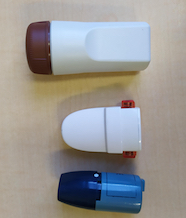2024
Journal - Research Article
Fan, C., Eedara, B. B., Sinha, S., Udden, M. K. M., Doyle, C., Banu, S., & Das, S. C. (2024). Triple combination dry powder formulation of pretomanid, moxifloxacin, and pyrazinamide for treatment of multidrug-resistant tuberculosis. International Journal of Pharmaceutics, 654, 123874. doi: 10.1016/j.ijpharm.2024.123984
Saha, T., Lyons, N., Yung, D. B. Y., Quiñones‑Mateu, M. E., Pletzer, D., & Das, S. C. (2024). Repurposing ebselen as an inhalable dry powder to treat respiratory tract infections. European Journal of Pharmaceutics & Biopharmaceutics, 195, 114170. doi: 10.1016/j.ejpb.2023.12.010
Journal - Research Other
Hare, C., Hadinoto, K., Das, S., & Smith, R. (2024). Dry powder coating in manufacturing processes. Frontiers in Chemical Engineering, 6, 1420110. doi: 10.3389/fceng.2024.1420110
Khadka, P., Dummer, J., Hill, P. C., & Das, S. C. (2024). The quest to deliver high-dose rifampicin: Can the inhaled approach help? [Review]. Expert Opinion on Drug Delivery, 21(1), 31-44. doi: 10.1080/17425247.2024.2301931
2023
Journal - Research Article
Eedara, B. B., Fan, C., Sinha, S., Khadka, P., & Das, S. C. (2023). Inhalable combination powder formulations for treating latent and multidrug-resistant tuberculosis: Formulation and in vitro characterization. Pharmaceutics, 15, 2354. doi: 10.3390/pharmaceutics15092354
Saha, T., Sinha, S., Harfoot, R., Quiñones‑Mateu, M. E., & Das, S. C. (2023). Inhalable dry powder containing remdesivir and disulfiram: Preparation and in vitro characterization. International Journal of Pharmaceutics, 645, 123411. doi: 10.1016/j.ijpharm.2023.123411
Saha, T., Sinha, S., Harfoot, R., Quiñones‑Mateu, M. E., & Das, S. C. (2023). Spray-dried inhalable microparticles combining remdesivir and ebselen against SARS-CoV-2 infection. Pharmaceutics, 15, 2229. doi: 10.3390/pharmaceutics15092229
Khadka, P., Dummer, J., Hill, P. C., Katare, R., & Das, S. C. (2023). A review of formulations and preclinical studies of inhaled rifampicin for its clinical translation. Drug Delivery & Translational Research, 13, 1246-1271. doi: 10.1007/s13346-022-01238-y
Khadka, P., Tucker, I. G., & Das, S. C. (2023). In vitro dissolution testing of rifampicin powder formulations for prediction of plasma concentration-time profiles after inhaled delivery. Pharmaceutical Research, 40, 1153-1163. doi: 10.1007/s11095-022-03439-z
Journal - Research Other
Das, S., Rades, T., & McDowell, A. (2023). In honor of Professor Ian Tucker. International Journal of Pharmaceutics. Advance online publication. doi: 10.1016/j.ijpharm.2023.122762
Conference Contribution - Published proceedings: Full paper
Bastola, R., Young, P. M., & Das, S. C. (2023). Influence of lung mucus on in vitro dissolution and absorption of an inhalable drug. In R. N. Dalby, J. Peart, D. Traini, P. M. Young & J. D. Suman (Eds.), Respiratory drug delivery. 2023, (pp. 417-420). Richmond, VA: RDD Online. [Full Paper]
Das, S. C., Khadka, P., Sinha, S., Katare, R., Hill, P. C., & Dummer, J. (2023). Towards the clinical translation of inhaled rifampicin for tuberculosis. In R. N. Dalby, J. Peart, D. Traini, P. M. Young & J. D. Suman (Eds.), Respiratory drug delivery. 2023, (pp. 11-18). Richmond, VA: RDD Online. [Full Paper]
Shah, R. M., Lyu, A., Walker, G. F., Katare, R., & Das, S. C. (2023). Inhaled ceftazidime dry powder developed using spray freeze drying technique. Proceedings of the 34th Drug Delivery to the Lungs (DDL) Conference. 34, (pp. 320-323). Retrieved from https://ddl-conference.com
Saha, T., Sinha, S., Harfoot, R., Quiñones‑Mateu, M. E., & Das, S. C. (2023). Development of inhalable dry powders combining replication and protease inhibitors of SARS-CoV-2. Proceedings of the 34th Drug Delivery to the Lungs (DDL) Conference. 34, (pp. 389-392). Retrieved from https://ddl-conference.com
Conference Contribution - Published proceedings: Abstract
Komal, K., Chen, S., Glass, M., & Das, S. C. (2023). Inhalable cannabidiol dry powder for treating chronic obstructive pulmonary disease. Proceedings of the New Zealand Controlled Release Society (NZCRS) Symposium. Retrieved from http://nzcrs.org.nz/#/home
Shah, R. M., Reily-Bell, M., Katare, R., Walker, G., & Das, S. (2023). Development and evaluation of microRNA-134 encapsulated cationic liposomes for chronic obstructive pulmonary disease. Pharmacy Education, 23(6), (pp. 149). doi: 10.46542/pe.2023.236.129157
Saha, T., Lyons, N., Yung, D., Pletzer, D., Quiñones Mateu, M. E., & Das, S. (2023). Inhalable ebselen dry powder for respiratory tract infections. Pharmacy Education, 23(6), (pp. 147). doi: 10.46542/pe.2023.236.129157
Bastola, R., Young, P. M., & Das, S. (2023). Influence of lung fluid protein types on in vitro dissolution and absorption of an inhalable drug. Pharmacy Education, 23(6), (pp. 133). doi: 10.46542/pe.2023.236.129157
Other Research Output
Das, S. (2023, January). Inhaler delivery for treating COVID-19. Faculty of Pharmacy Seminar, University of Dhaka, Dhaka, Bangladesh. [Department Seminar].
Das, S. (2023, January). Excellence in teaching, research and service: A New Zealand university perspective. Institutional Quality Assurance Cell (IQAC) Seminar, Jahangirnagar University, Dhaka, Bangladesh. [Research Presentation].
Das, S. (2023, May). Drug delivery to treat respiratory diseases efficiently. College of Pharmacy, University of Sharjah, Sharjah, United Arab Emirates. [Research Presentation].
Das, S. (2023, January). Considerations for inhaler development. Healthcare Pharmaceuticals Ltd Seminar, Gazipur, Bangladesh. [Research Presentation].
Das, S. (2023, January). Excellence in teaching and research in the University of Otago, New Zealand. Department of Pharmacy Seminar, East West University, Dhaka, Bangladesh. [Department Seminar].
Das, S. (2023, March). Inhaled formulations for respiratory diseases. Department of Microbiology and Immunology Seminar, University of Otago, Dunedin, New Zealand. [Department Seminar].
2022
Journal - Research Article
Adhikari, B. R., & Das, S. C. (2022). Amorphicity and aerosolization of soluplus-based inhalable spray dried powders. Pharmaceutics, 14(12), 2618. doi: 10.3390/pharmaceutics14122618
Eedara, B. B., Bastola, R., & Das, S. C. (2022). Dissolution and absorption of inhaled drug particles in the lungs [Review]. Pharmaceutics, 14, 2667. doi: 10.3390/pharmaceutics14122667
Adhikari, B. R., Sinha, S., Lyons, N., Pletzer, D., Lamont, I., Gordon, K. C., & Das, S. C. (2022). Inhalable ceftazidime-roflumilast powder targeting infection and inflammation: Influence of incorporating roflumilast into ceftazidime-leucine co-amorphous formulation. European Journal of Pharmaceutics & Biopharmaceutics, 180, 260-268. doi: 10.1016/j.ejpb.2022.10.005
Adhikari, B. R., Gordon, K. C., & Das, S. C. (2022). Solid state of inhalable high dose powders. Advanced Drug Delivery Reviews, 189, 114468. doi: 10.1016/j.addr.2022.114468
Saha, T., Quiñones‑Mateu, M. E., & Das, S. C. (2022). Inhaled therapy for COVID-19: Considerations of drugs, formulations and devices. International Journal of Pharmaceutics, 624, 122042. doi: 10.1016/j.ijpharm.2022.122042
Saha, T., Sinha, S., Harfoot, R., Quiñones Mateu, M. E., & Das, S. C. (2022). Manipulation of spray-drying conditions to develop an inhalable ivermectin dry powder. Pharmaceutics, 14(7), 1432. doi: 10.3390/pharmaceutics14071432
Adhikari, B. R., Dummer, J., Gordon, K. C., & Das, S. C. (2022). An expert opinion on respiratory delivery of high dose powders for lung infections. Expert Opinion on Drug Delivery, 19(7), 795-813. doi: 10.1080/17425247.2022.2089111
Adhikari, B. R., Sinha, S., Gordon, K. C., & Das, S. C. (2022). Amino acids improve aerosolization and chemical stability of potential inhalable amorphous spray-dried ceftazidime for Pseudomonas aeruginosa lung infection. International Journal of Pharmaceutics, 621, 121799. doi: 10.1016/j.ijpharm.2022.121799
Adhikari, B. R., Bērziņš, K., Fraser-Miller, S. J., Cavallaro, A., Gordon, K. C., & Das, S. C. (2022). Optimization of methionine in inhalable high-dose spray-dried amorphous composite particles using response surface method, infrared and low frequency Raman spectroscopy. International Journal of Pharmaceutics, 614, 121446. doi: 10.1016/j.ijpharm.2021.121446
Conference Contribution - Published proceedings: Abstract
Bastola, R., Young, P. M., & Das, S. C. (2022). Impact of lung fluid components on absorption of medication. In L. Wilson, H. Harcombe, P. Jayakaran, L. Burga, J. Antony, K. Morgaine, M. Garelja, A. Middleton, M. Anwar & T. Milne (Eds.), Proceedings of the 263rd Otago Medical School Research Society (OMSRS) Meeting: PhD Student Speaker Awards. Dunedin, New Zealand: OMSRS. Retrieved from https://ourarchive.otago.ac.nz/handle/10523/12839
Saha, T., Sinha, S., Harfoot, R., Quiñones‑Mateu, M. E., & Das, S. C. (2022). Development of remdesivir and ebselen containing inhalable dry powder for COVID-19. Proceedings of the Australasian Pharmaceutical Science Association (APSA) and the Australasian Society of Clinical and Experimental Pharmacologists and Toxicologists (ASCEPT) Joint Conference. 566. Retrieved from https://www.asceptasm.com
Conference Contribution - Poster Presentation (not in published proceedings)
Shah, R. M., Katare, R., Walker, G., & Das, S. C. (2022, November). Physicochemical characterization of exosome-mimetic nanoparticles for chronic obstructive pulmonary disease. Poster session presented at the New Zealand Controlled Release Society (NZCRS) Symposium, Auckland, New Zealand.
Komal, K., Glass, M., & Das, S. C. (2022, November). Prospects of cannabidiol inhalation. Poster session presented at the New Zealand Controlled Release Society (NZCRS) Symposium, Auckland, New Zealand.
Saha, T., Sinha, S., Harfoot, R., Quiñones‑Mateu, M. E., & Das, S. C. (2022, November). Inhalable dry powder of synergistic drug combinations to treat COVID-19. Poster session presented at the Otago Global Health Institute (OGHI) 14th Annual Conference: Reimagining Partnerships, Dunedin, New Zealand.
Conference Contribution - Verbal presentation and other Conference outputs
Saha, T., Sinha, S., Harfoot, R., Quiñones‑Mateu, M. E., & Das, S. C. (2022, November). Inhalable dry powder containing remdesivir and disulfiram for COVID-19. Verbal presentation at the School of Pharmacy Research Day, Dunedin, New Zealand.
Bastola, R., Young, P. M., & Das, S. C. (2022, November). Influence of thickness and movement of lung fluid on dissolution and adsorption of an inhalable drug. Verbal presentation at the School of Pharmacy Research Day, Dunedin, New Zealand.
Shah, R., Walker, G., Katare, R., & Das, S. (2022, November). Spray-freeze drying: An emerging technique for producing inhalable microparticles of thermosensitive bioactives. Verbal presentation at the School of Pharmacy Research Day, Dunedin, New Zealand.
Das, S. (2022, November). Overview of research at the School of Pharmacy. Verbal presentation at the School of Pharmacy Research Day, Dunedin, New Zealand.
Saha, T., Sinha, S., Harfoot, R., Quiñones‑Mateu, M. E., & Das, S. C. (2022, November). Remdesivir and ebselen containing inhalable dry powder against SARS-CoV-2. Verbal presentation at the New Zealand Controlled Release Society (NZCRS) Symposium, Auckland, New Zealand.
Bastola, R., Young, P. M., & Das, S. C. (2022, November). Impact of lung surfactant on in vitro dissolution and absorption of an inhalable drug. Verbal presentation at the New Zealand Controlled Release Society (NZCRS) Symposium, Auckland, New Zealand.
Das, S. (2022, September). Formulation development and delivery for effective treatment of tuberculosis. Keynote presentation at the International Conference on Drug Discovery & Development (ICDD): Pharma Fest, Dhaka, Bangladesh.
Shah, R., Walker, G., Katare, R., & Das, S. C. (2022, November). Spray-freeze drying: A hybrid particle engineering technique for producing highly porous and aerosolizable dry powder. Verbal presentation at the Bioengineering@Otago Showcase, [Online].
Das, S. (2022, November). Particle engineering for increased drug delivery to the lung. Verbal presentation at the Bioengineering@Otago Showcase, [Online].
Saha, T., Sinha, S., Harfoot, R., Quiñones‑Mateu, M. E., & Das, S. C. (2022, November). Inhalable antivirals for SARS-CoV-2 infections. Verbal presentation at the Bioengineering@Otago Showcase, [Online].
Das, S. (2022, November). Pulmonary delivery of controlled release powders for lung diseases. Invited presentation at the New Zealand Controlled Release Society (NZCRS) Symposium, Auckland, New Zealand.
Shah, R. M., Walker, G. F., Katare, R., & Das, S. C. (2022, August-September). Differential regulation of microRNAs associated with COPD in smokers. Verbal presentation at the 16th New Zealand Medical Sciences Congress (MedSci), Queenstown, New Zealand.
Other Research Output
Das, S. (2022, October). Drug delivery for efficient treatment. UOC Research Seminar Series, University of Otago, Christchurch, New Zealand. [Research Presentation].
2021
Chapter in Book - Research
Das, S. C., Khadka, P., Shah, R., McGill, S., & Smyth, H. D. C. (2021). Nanomedicine in pulmonary delivery. In P. Kesharwani, S. Taurin & K. Greish (Eds.), Theory and applications of nonparenteral nanomedicines. (pp. 319-354). London, UK: Elsevier. doi: 10.1016/B978-0-12-820466-5.00014-4
Journal - Research Article
Momin, M. A. M., Adhikari, B. R., Sinha, S., Larson, I., & Das, S. C. (2021). Roflumilast powders for chronic obstructive pulmonary disease: Formulation design and the influence of device, inhalation flow rate, and storage relative humidity on aerosolization. Pharmaceutics, 13, 1254. doi: 10.3390/pharmaceutics13081254
Khadka, P., Sinha, S., Tucker, I. G., Dummer, J., Hill, P. C., Katare, R., & Das, S. C. (2021). Pharmacokinetics of rifampicin after repeated intra-tracheal administration of amorphous and crystalline powder formulations to Sprague Dawley rats. European Journal of Pharmaceutics & Biopharmaceutics, 162, 1-11. doi: 10.1016/j.ejpb.2021.02.011
Khadka, P., Sinha, S., Tucker, I. G., Dummer, J., Hill, P. C., Katare, R., & Das, S. C. (2021). Studies on the safety and the tissue distribution of inhaled high-dose amorphous and crystalline rifampicin in a rat model. International Journal of Pharmaceutics, 597, 120345. doi: 10.1016/j.ijpharm.2021.120345
Journal - Research Other
Saha, T., Khadka, P., & Das, S. C. (2021). Alcohol-based hand sanitizer: Composition, proper use and precautions. Germs, 11(3), 408-417. doi: 10.18683/germs.2021.1278
Ameratunga, R., Woon, S.-T., Steele, R., Snell, R., Medlicott, N., Mears, E., … Das, S., … Quiñones‑Mateu, M. E. (2021). The nose and the stomach play a critical role in the NZACE2-Pātari* (modified ACE2) drug treatment project of SARS-CoV-2 infection. Expert Review of Clinical Immunology, 17(6), 553-560. doi: 10.1080/1744666x.2021.1912596
Bastola, R., Young, P. M., & Das, S. C. (2021). Simulation of respiratory tract lining fluid for in vitro dissolution study. Expert Opinion on Drug Delivery, 18(8), 1091-1100. doi: 10.1080/17425247.2021.1882991
Conference Contribution - Published proceedings: Full paper
Khadka, P., Sinha, S., Tucker, I. G., Dummer, J., Hill, P. C., Katare, R., & Das, S. C. (2021). High-dose inhaled rifampicin powder formulations: Preparation, in vitro characterization and in vivo evaluation. Proceedings of the Drug Delivery to the Lungs (DDL) Conference (Vol. 32). Retrieved from https://ddl-conference.com
Adhikari, B. R., Gordon, K. C., & Das, S. C. (2021). Co-amorphization: A formulation strategy for amorphous high dose dry powder to treat lung infections. Proceedings of the Drug Delivery to the Lungs (DDL) Conference (Vol. 32). Retrieved from https://ddl-conference.com
Conference Contribution - Published proceedings: Abstract
Khadka, P., Sinha, S., Hill, P. C., Dummer, J., Tucker, I. G., Katare, R. G., & Das, S. C. (2021). In vitro and in vivo evaluation of high-dose inhaled rifampicin powder formulations for tuberculosis treatment. New Zealand Medical Journal, 134(1547), (pp. 139). Retrieved from https://www.nzma.org.nz/journal
Adhikari, B. R., Berzins, K., Fraser-Miller, S. J., Gordon, K. C., & Das, S. C. (2021). Methionine offers superior aerosolization stability over leucine for inhalable high-dose spray-dried kanamycin formulation. Journal of Aerosol Medicine & Pulmonary Drug Delivery, 34(3), (pp. A15). doi: 10.1089/jamp.2021.ab01.abstracts
Conference Contribution - Verbal presentation and other Conference outputs
Das, S. (2021, December). Inhaled treatment for COVID-19. Verbal presentation at the Australasian Pharmaceutical Science Association (APSA) Annual Conference, [Online].
2020
Journal - Research Article
Adhikari, B. R., Bērziņš, K., Fraser-Miller, S. J., Gordon, K. C., & Das, S. C. (2020). Co-amorphization of kanamycin with amino acids improves aerosolization. Pharmaceutics, 12(8), 715. doi: 10.3390/pharmaceutics12080715
Khadka, P., Hill, P. C., Zhang, B., Katare, R., Dummer, J., & Das, S. C. (2020). A study on polymorphic forms of rifampicin for inhaled high dose delivery in tuberculosis treatment. International Journal of Pharmaceutics, 587, 119602. doi: 10.1016/j.ijpharm.2020.119602
Journal - Research Other
Ameratunga, R., Lehnert, K., Leung, E., Comoletti, D., Snell, R., Woon, S.-T., … Medlicott, N., Das, S., … Quiñones‑Mateu, M., … Jordan, A. (2020). Inhaled modified angiotensin converting enzyme 2 (ACE2) as a decoy to mitigate SARS-CoV-2 infection. New Zealand Medical Journal, 133(1515), 112-118. Retrieved from https://www.nzma.org.nz/journal
Conference Contribution - Published proceedings: Abstract
Das, S. C., Saha, T., Shah, R., Wood, N., Adhikari, B., Bastola, R., Khadka, P., & Marra, C. A. (2020). Hand sanitizer for hand hygiene during COVID-19 in New Zealand: A response to the community's need by staff and students of the School of Pharmacy, University of Otago. Proceedings of the Australasian Society of Clinical and Experimental Pharmacologists and Toxicologists (ASCEPT) and the Australasian Pharmaceutical Science Association (APSA) Joint Scientific Meeting: Global Solutions for Global Challenges. Retrieved from https://www.asceptasm.com/2020-annual-scientific-meeting
Adhikari, B. R., Gordon, K. C., & Das, S. C. (2020). Co-amorphous kanamycin-amino acid spray-dried inhalable particles: The influence of feed concentration in achieving high aerosolization. Proceedings of the Australasian Society of Clinical and Experimental Pharmacologists and Toxicologists (ASCEPT) and the Australasian Pharmaceutical Science Association (APSA) Joint Scientific Meeting: Global Solutions for Global Challenges. Retrieved from https://www.asceptasm.com/2020-annual-scientific-meeting
Khadka, P., Sinha, S., Tucker, I. G., Dummer, J., Hill, P. C., Katare, R., & Das, S. C. (2020). Safety of a single high-dose inhaled rifampicin in Sprague Dawley rats. Journal of Aerosol Medicine & Pulmonary Drug Delivery, 33(2), (pp. A11). doi: 10.1089/jamp.2020.ab01.abstracts
2019
Journal - Research Article
Eedara, B. B., Tucker, I. G., & Das, S. C. (2019). A STELLA simulation model for in vitro dissolution testing of respirable size particles. Scientific Reports, 9(1), 18522. doi: 10.1038/s41598-019-55164-0
Momin, M. A. M., Rangnekar, B., Sinha, S., Cheung, C.-Y., Cook, G. M., & Das, S. C. (2019). Inhalable dry powder of Bedaquiline for pulmonary tuberculosis: In vitro physiochemical characterization, antimicrobial activity and safety studies. Pharmaceutics, 11(10), 502. doi: 10.3390/pharmaceutics11100502
Rangnekar, B., Momin, M. A. M., Eedara, B. B., Sinha, S., & Das, S. C. (2019). Bedaquiline containing triple combination powder for inhalation to treat drug-resistant tuberculosis. International Journal of Pharmaceutics, 570, 118689. doi: 10.1016/j.ijpharm.2019.118689
Momin, M. A. M., Rangnekar, B., Larson, I., Sinha, S., & Das, S. C. (2019). Dry powder formulation combining bedaquiline with pyrazinamide for latent and drug-resistant tuberculosis. Advanced Powder Technology, 30(11), 2473-2482. doi: 10.1016/j.apt.2019.07.016
Eedara, B. B., Tucker, I. G., Zujovic, Z. D., Rades, T., Price, J. R., & Das, S. C. (2019). Crystalline adduct of moxifloxacin with trans-cinnamic acid to reduce the aqueous solubility and dissolution rate for improved residence time in the lungs. European Journal of Pharmaceutical Sciences, 136, 104961. doi: 10.1016/j.ejps.2019.104961
Momin, M. A. M., Tucker, I. G., & Das, S. C. (2019). The influence of storage relative humidity on aerosolization of co-spray dried powders of hygroscopic kanamycin with the hydrophobic drug rifampicin. Drug Development & Industrial Pharmacy, 45(7), 1205-1213. doi: 10.1080/03639045.2019.1607869
Momin, M. A. M., Sinha, S., Tucker, I. G., & Das, S. C. (2019). Carrier-free combination dry powder inhaler formulation of ethionamide and moxifloxacin for treating drug-resistant tuberculosis. Drug Development & Industrial Pharmacy, 45(8), 1321-1331. doi: 10.1080/03639045.2019.1609494
Eedara, B. B., Tucker, I. G., & Das, S. C. (2019). In vitro dissolution testing of respirable size anti-tubercular drug particles using a small volume dissolution apparatus. International Journal of Pharmaceutics, 559, 235-244. doi: 10.1016/j.ijpharm.2019.01.035
Conference Contribution - Published proceedings: Abstract
Khadka, P., Sinha, S., Katare, R., & Das, S. C. (2019). Identification of suitable polymorphic forms of rifampicin for inhaled high dose delivery. Proceedings of the Australasian Pharmaceutical Science Association (APSA) Annual Conference: Working Together Toward Better Health Outcomes. (pp. 20). Retrieved from http://www.apsa-online.org
Momin, M. A. M., Sinha, S., Tucker, I. G., & Das, S. C. (2019). High dose spray-dried powders for treating tuberculosis. Journal of Aerosol Medicine & Pulmonary Drug Delivery, 32(2), (pp. A23). doi: 10.1089/jamp.2019.ab01.abstracts
2018
Journal - Research Article
Momin, M. A. M., Tucker, I. G., & Das, S. C. (2018). High dose dry powder inhalers to overcome the challenges of tuberculosis treatment. International Journal of Pharmaceutics, 550(1-2), 398-417. doi: 10.1016/j.ijpharm.2018.08.061
Khadka, P., Dummer, J., Hill, P. C., & Das, S. C. (2018). Considerations in preparing for clinical studies of inhaled rifampicin to enhance tuberculosis treatment. International Journal of Pharmaceutics, 548(1), 244-254. doi: 10.1016/j.ijpharm.2018.07.011
Momin, M. A. M., Tucker, I. G., Doyle, C. S., Denman, J. A., & Das, S. C. (2018). Manipulation of spray-drying conditions to develop dry powder particles with surfaces enriched in hydrophobic material to achieve high aerosolization of a hygroscopic drug. International Journal of Pharmaceutics, 543, 318-327. doi: 10.1016/j.ijpharm.2018.04.003
Eedara, B. B., Rangnekar, B., Doyle, C., Cavallaro, A., & Das, S. C. (2018). The influence of surface active L-leucine and 1,2-dipalmitoyl-sn-glycero-3-phosphatidylcholine (DPPC) in the improvement of aerosolization of pyrazinamide and moxifloxacin co-spray dried powders. International Journal of Pharmaceutics, 542(1-2), 72-81. doi: 10.1016/j.ijpharm.2018.03.005
Momin, M. A. M., Rangnekar, B., & Das, S. C. (2018). Development and validation of a RP-HPLC method for simultaneous quantification of bedaquiline (TMC207), moxifloxacin and pyrazinamide in a pharmaceutical powder formulation for inhalation. Journal of Liquid Chromatography & Related Technologies, 41(8), 415-421. doi: 10.1080/10826076.2018.1437748
Momin, M. A. M., Tucker, I. G., Doyle, C. S., Denman, J. A., Sinha, S., & Das, S. C. (2018). Co-spray drying of hygroscopic kanamycin with the hydrophobic drug rifampicin to improve the aerosolization of kanamycin powder for treating respiratory infections. International Journal of Pharmaceutics, 541(1-2), 26-36. doi: 10.1016/j.ijpharm.2018.02.026
Journal - Research Other
Das, S. C., Stewart, P. J., & Tucker, I. G. (2018). The respiratory delivery of high dose dry powders. International Journal of Pharmaceutics, 550, 486-487. doi: 10.1016/j.ijpharm.2018.09.014
Conference Contribution - Published proceedings: Abstract
Eedara, B. B., Tucker, I. G., Rades, T., Zujovic, Z. D., & Das, S. C. (2018). Cocrystal approach to decrease the dissolution of drugs intended for treating tuberculosis. Proceedings of the Australasian Pharmaceutical Science Association (APSA) Conference: Science, Practice, Education: Partnering in Health. 164. Retrieved from http://www.apsa-online.org
Eedara, B. B., Tucker, I. G., Rades, T., & Das, S. C. (2018). Cocrystal approach to improving treatment of pulmonary tuberculosis. Proceedings of the Otago Global Health Institute (OGHI) 11th Annual Conference. (pp. 20-21). Retrieved from https://www.otago.ac.nz/global-health/annual-conference
Khadka, P., Dummer, J., Hill, P. C., & Das, S. C. (2018). Inhaled rifampicin for the treatment of tuberculosis. Proceedings of the Otago Global Health Institute (OGHI) 11th Annual Conference. (pp. 20). Retrieved from https://www.otago.ac.nz/global-health/annual-conference
Conference Contribution - Verbal presentation and other Conference outputs
Eedara, B. B., Tucker, I. G., & Das, S. C. (2018, August). In vitro dissolution behaviour of respirable anti-tubercular drug particles. Verbal presentation at the Queenstown Molecular Biology (QMB) Meetings, Queenstown, New Zealand.
2017
Chapter in Book - Research
Hadjittofis, E., Das, S. C., Zhang, G. G. Z., & Heng, J. Y. Y. (2017). Interfacial phenomena. In Y. Qiu, Y. Chen, G. G. Z. Zhang, L. Yu & R. V. Mantri (Eds.), Developing solid oral dosage forms: Pharmaceutical theory & practice. (2nd ed.) (pp. 225-252). London, UK: Academic Press. doi: 10.1016/B978-0-12-802447-8.00008-X
Journal - Research Article
Momin, M. A. M., Sinha, S., Tucker, I. G., Doyle, C., & Das, S. C. (2017). Dry powder formulation of kanamycin with enhanced aerosolization efficiency for drug-resistant tuberculosis. International Journal of Pharmaceutics, 528(1-2), 107-117. doi: 10.1016/j.ijpharm.2017.06.004
Momin, M. A. M., Thien, S. J., Krittaphol, W., & Das, S. C. (2017). Simultaneous HPLC assay for pretomanid (PA-824), moxifloxacin and pyrazinamide in an inhaler formulation for drug-resistant tuberculosis. Journal of Pharmaceutical & Biomedical Analysis, 135, 133-139. doi: 10.1016/j.jpba.2016.11.046
Conference Contribution - Published proceedings: Full paper
Das, S. C., Fan, C., Eedara, B. B., & Sinha, S. (2017). A triple combination anti-tubercular dry powder formulation for treating both drug susceptible and multidrug resistant tuberculosis: Formulation and in vitro characterization. Proceedings of the Drug Delivery to the Lungs (DDL) Conference: Shaping the Next 25 Years of Nasal and Pulmonary Drug Delivery. (pp. 206-209). Retrieved from https://ddl-conference.com
Eedara, B. B., Tucker, I. G., & Das, S. C. (2017). Cocrystal approach to reduce the aqueous solubility and dissolution rate for improved residence time of an anti-tubercular drug in the lungs. Proceedings of the Drug Delivery to the Lungs (DDL) Conference: Shaping the Next 25 Years of Nasal and Pulmonary Drug Delivery. (pp. 54-57). Retrieved from https://ddl-conference.com
Conference Contribution - Published proceedings: Abstract
Das, S. C., Rangnekar, B., & Eedara, B. B. (2017). The influence of lung surfactant, 1,2 dipalmitoyle-sn-glycero-3-phosphatidylcholine (DPPC) on the aerosolization of two anti-tubercular drugs, pyrazinamide and moxifloxacin. Journal of Aerosol Medicine & Pulmonary Drug Delivery, 30(4), (pp. A24). doi: 10.1089/jamp.2017.ab02.abstracts
Momin, M. A. M., Tucker, I. G., Doyle, C., Denman, J., & Das, S. C. (2017). Enrichment of the surface of spray-dried powder particles with a hydrophobic material to improve their aerosolization. Journal of Aerosol Medicine & Pulmonary Drug Delivery, 30(4), (pp. A17). doi: 10.1089/jamp.2017.ab02.abstracts
2016
Chapter in Book - Research
Das, S. C., & Stewart, P. J. (2016). Understanding the respiratory delivery of high dose anti-tubercular drugs. In A. J. Hickey, A. Misra & P. B. Fourie (Eds.), Drug delivery systems for tuberculosis prevention and treatment. (pp. 258-274). Chichester, UK: Wiley. doi: 10.1002/9781118943182.ch13
Journal - Research Article
Das, S. C., & Stewart, P. J. (2016). The influence of lung surfactant liquid crystalline nanostructures on respiratory drug delivery. International Journal of Pharmaceutics, 514(2), 465-474. doi: 10.1016/j.ijpharm.2016.06.029
Eedara, B. B., Tucker, I. G., & Das, S. C. (2016). Phospholipid-based pyrazinamide spray-dried inhalable powders for treating tuberculosis. International Journal of Pharmaceutics, 506(1-2), 174-183. doi: 10.1016/j.ijpharm.2016.04.038
Conference Contribution - Published proceedings: Abstract
Rangnekar, B., Eedara, B. B., & Das, S. C. (2016). Co-spray drying of a lung surfactant, 1,2-dipalmitoyl-sn-glycero-3-phosphatidylcholine (DPPC) with anti-TB drugs increases aerosolization of the drugs. Proceedings of the Drug Delivery Australia Conference. (pp. 42). Retrieved from http://www.crsaustralia.org/
Das, S., & Anakin, M. (2016). Constructing a reflective spiral: Developing responsive teaching practice by addressing student feedback. Proceedings of the Tertiary Education Research in New Zealand (TERNZ) Conference. Retrieved from http://herdsa.org.nz/ternz/2016
Momin, M. A. M., Tucker, I. G., & Das, S. C. (2016). Combination dry powder formulation of moxifloxacin and ethionamide for treating drug-resistant
tuberculosis. Proceedings of the Australasian Pharmaceutical Science Association (APSA) Conference: Precision Medicine, Personalising Healthcare. 214. Retrieved from http://www.apsa-online.org/
Das, S. C. (2016). Powder formulations for respiratory delivery to treat tuberculosis. Proceedings of the Australasian Pharmaceutical Science Association (APSA) Conference: Precision Medicine, Personalising Healthcare. 203. Retrieved from http://www.apsa-online.org/
Rangnekar, B., Eedara, B. B., & Das, S. C. (2016). Can the co-spray drying of a lung surfactant, 1,2-dipalmitoyl-sn-glycero-3-phosphatidylcholine (DPPC) with anti-TB drugs increase aerosolization of the drugs? Proceedings of the Australasian Pharmaceutical Science Association (APSA) Conference: Precision Medicine, Personalising Healthcare. 115. Retrieved from http://www.apsa-online.org/
Eedara, B. B., Tucker, I. G., & Das, S. C. (2016). Modulating the aqueous solubility of moxifloxacin by co-crystallization with cinnamic acid. Proceedings of the Diagnostics, Drugs, Devices, Discovery (D4) Conference. Retrieved from http://www.otago.ac.nz/d4/index.html
Thien, S. J., Momin, M. A. M., Krittaphol, W., & Das, S. C. (2016). HPLC method for simultaneous quantification of three drugs used for drug-resistant tuberculosis. Proceedings of the Diagnostics, Drugs, Devices, Discovery (D4) Conference. Retrieved from http://www.otago.ac.nz/d4/index.html
Momin, M. A. M., Tucker, I. G., & Das, S. C. (2016). Carrier-free dry powder formulation of ethionamide for drug-resistant tuberculosis. Proceedings of the Diagnostics, Drugs, Devices, Discovery (D4) Conference. Retrieved from http://www.otago.ac.nz/d4/index.html
Momin, M. A. M., Tucker, I. G., & Das, S. C. (2016). A formulation approach to improve aerosolization of powders for inhalation to combat drug-resistant pulmonary infections. Proceedings of the Otago Global Health Institute (OGHI) 9th Annual Conference. (pp. 19). Retrieved from http://dnmeds.otago.ac.nz/departments/psm/research/international_hlth/conference/
2015
Journal - Research Article
Das, S. C., Tucker, I. G., & Stewart, P. J. (2015). Surface energy determined by inverse gas chromatography as a tool to investigate particulate interactions in dry powder inhalers. Current Pharmaceutical Design, 21(27), 3932-3944. Retrieved from http://europepmc.org/abstract/MED/26290201
Tucker, I. G., Das, S. C., & Stewart, P. J. (2015). A view on the less-than-rational development of drug delivery systems: The example of dry powder inhalers. Journal of Drug Delivery Science & Technology, 30, 310-317. doi: 10.1016/j.jddst.2015.06.008
Das, S., Tucker, I., & Stewart, P. (2015). Inhaled dry powder formulations for treating tuberculosis. Current Drug Delivery, 12(1), 26-39.
Shi, J., Das, S., Morton, D., & Stewart, P. (2015). The kinetics of de-agglomeration of magnesium stearate dry-coated salbutamol sulphate powders. KONA Powder & Particle Journal, (32), 131-142. doi: 10.14356/kona.2015001
Conference Contribution - Published proceedings: Full paper
Das, S. C. (2015). Stabilization of amorphous powders for inhalation prepared by spray drying. In R. N. Dalby, P. R. Byron, J. Peart, J. D. Suman, P. M. Young & D. Traini (Eds.), Respiratory Drug Delivery Europe 2015 (Vol. 2). (pp. 501-506). Richmond, VA: Virginia Commonwealth University. [Full Paper]
Conference Contribution - Published proceedings: Abstract
Eedara, B. B., Tucker, I. G., & Das, S. C. (2015). Preparation and characterization of the spray dried pyrazinamide phospholipid microparticles for treating latent tuberculosis. Proceedings of the Diagnostic Drug Device Discovery (D4) Conference. Retrieved from https://www.regonline.com.au/builder/site/Default.aspx?EventID=1758070
Das, S. C. (2015). Devices for pulmonary delivery of powdered drugs. Proceedings of the Diagnostic Drug Device Discovery (D4) Conference. Retrieved from https://www.regonline.com.au/builder/site/Default.aspx?EventID=1758070
Momin, M. A. M., Tucker, I. G., & Das, S. C. (2015). Dry powder inhalers of kanamycin with enhanced aerosolization efficiency for drug resistant tuberculosis. Proceedings of the Diagnostic Drug Device Discovery (D4) Conference. Retrieved from https://www.regonline.com.au/builder/site/Default.aspx?EventID=1758070
Eedara, B. B., Tucker, I. G., & Das, S. C. (2015). Phospholipid-based pyrazinamide spray-dried inhalable powders for treating tuberculosis. Proceedings of the 8th Annual Otago International Health Research Network (OIHRN) Conference. (pp. 6). Retrieved from http://dnmeds.otago.ac.nz/departments/psm/research/international_hlth
Momin, M. A. M., Tucker, I. G., & Das, S. C. (2015). Spray-dried kanamycin powder for inhalation to treat drug resistant tuberculosis. Proceedings of the 8th Annual Otago International Health Research Network (OIHRN) Conference. (pp. 5-6). Retrieved from http://dnmeds.otago.ac.nz/departments/psm/research/international_hlth
Chen, L., & Das, S. C. (2015). Development of a physically stable high dose powder for inhalation by spray-drying. Proceedings of the Australasian Pharmaceutical Science Association and the Australasian Society of Clinical and Experimental Pharmacologists and Toxicologists (APSA-ASCEPT) Joint Scientific Meeting: Drugs to Medicines: Up Close and Personal. 241. Retrieved from http://www.asceptasm.com/
2014
Conference Contribution - Published proceedings: Abstract
Das, S. (2014). The impact of high drug concentration of anti-tubercular drugs on lung surfactant monolayer. Journal of Aerosol Medicine & Pulmonary Drug Delivery, 27(6), (pp. A-5). doi: 10.1089/jamp.2014.ab02.abstracts
Das, S., Shi, J., Morton, D., & Stewart (2014). Use of powder bed tensile strength to explain the improved de-agglomeration of intensive dry coated salbutamol sulphate using magnesium stearate. Proceedings of the 5th Pharmaceutical Sciences World Congress (PSWC). Retrieved from http://www.fip.org/pswc2014/Melbourne/2041/Programme/
Das, S., Stewart, Shi, J., & Morton, D. (2014). Understanding the de-agglomeration kinetics of dry coated powders. Proceedings of the 5th Pharmaceutical Sciences World Congress (PSWC). Retrieved from http://www.fip.org/pswc2014/Melbourne/2041/Programme/
Conference Contribution - Verbal presentation and other Conference outputs
Das, S. (2014, November). Pulmonary delivery of spray-dried powders using dry powder inhalers. Invited presentation at the Devices for Diagnostics and Drug Delivery (D4) Conference, Dunedin, New Zealand.
Other Research Output
Das, S. (2014, June). Emerging powder formulations for pulmonary delivery for treating lung diseases. Otago Postgraduate Medical Society (OPMS) Medical Forum, Dunedin, New Zealand. [Research Presentation].
Das, S. (2014, March). Pulmonary delivery of powder formulations for treating lung diseases. Department of Pharmacology & Toxicology Seminar, University of Otago, Dunedin, New Zealand. [Department Seminar].
Das, S. (2014, March). Pulmonary drug delivery for treating chronic pulmonary conditions. School of Pharmacy Seminar, University of Otago, Dunedin, New Zealand. [Department Seminar].
2013
Journal - Research Article
Allahham, A., Stewart, P. J., & Das, S. C. (2013). Improving the de-agglomeration and dissolution of a poorly water soluble drug by decreasing the agglomerate strength of the cohesive powder. International Journal of Pharmaceutics, 457(1), 101-109. doi: 10.1016/j.ijpharm.2013.09.030
Das, S. C., Behara, S. R. B., Morton, D. A. V., Larson, I., & Stewart, P. J. (2013). Importance of particle size and shape on the tensile strength distribution and de-agglomeration of cohesive powders. Powder Technology, 249, 297-303. doi: 10.1016/j.powtec.2013.08.034
Conference Contribution - Published proceedings: Full paper
Das, S. C., Luu, J., Morton, D. A. V., & Stewart, P. J. (2013). A novel approach to develop high dose drug alone inhaler. Proceedings of the Drug Delivery to the Lungs 24 (DDL24) Conference. (pp. 278-281). The Aerosol Society. [Full Paper]
Conference Contribution - Published proceedings: Abstract
Das, S. C., Morton, D. A. V., & Stewart, P. (2013). Strategies for developing high dose powders for inhalation to treat chronic lung conditions. Proceedings of the Australasian Pharmaceutical Science Association (APSA) Conference. Retrieved from http://apsa-online.org/home.html
Das, S. C., Zhou, Q., Morton, D. A. V., & Stewart, P. (2013). Application of surface energy distributions by inverse gas chromatography to distinguish the effect of magnesium stearate on the surface energy of lactoses after conventional mixing and mechanofusion. Journal of Aerosol Medicine & Pulmonary Drug Delivery, 26(4), (pp. A-7-A-8). doi: 10.1089/jamp.2013.01ab
Das, S. C., Gaisford, S., & Stewart, P. J. (2013). Understanding the relaxation of micronised indomethacin by surface energy distributions determined by inverse gas chromatography. Journal of Aerosol Medicine & Pulmonary Drug Delivery, 26(5), (pp. A-4). doi: 10.1089/jamp.2013.ab01
Das, S. C., Behara, S. R. B., Larson, I., Morton, D. A. V., & Stewart, P. J. (2013). Influence of intermediate cohesive fraction of lactose on lactose powder aerosolisation behaviour determined by powder agglomerate strength distributions. Journal of Aerosol Medicine & Pulmonary Drug Delivery, 26(5), (pp. A-4). doi: 10.1089/jamp.2013.ab01
Das, S. C., Stewart, P. J., & Gaisford, S. (2013). Understanding the recrystallization behavior of amorphous indomethacin during ball milling. Journal of Aerosol Medicine & Pulmonary Drug Delivery, 26(5), (pp. A-3-A-4). doi: 10.1089/jamp.2013.ab01
Das, S. C., & Stewart, P. J. (2013). Surface energy distributions: A promising technique for understanding materials and processes used for inhalation. Proceedings of the Inhalation Asia (IA) Conference. (pp. 69). Retrieved from www.inhalationasia.org
Das, S. C., Morton, D. A. V., & Stewart, P. J. (2013). High dose drug only respiratory delivery: Novel approaches to understand aerosolisation of powders. Proceedings of the Inhalation Asia (IA) Conference. (pp. 30). Retrieved from www.inhalationasia.org
Das, S. C., Tucker, I. G., & Stewart, P. J. (2013). Advances on pulmonary delivery of dry powder formulations for tuberculosis. Proceedings of the 6th Annual Otago International Health Research Network (OIHRN) Conference. (pp. 9). Retrieved from http://dnmeds.otago.ac.nz/departments/psm/research/international_hlth/conference/index.html
2012
Journal - Research Article
Das, S. C., Behara, S. R. B., Bulitta, J. B., Morton, D. A. V., Larson, I., & Stewart, P. J. (2012). Powder strength distributions for understanding de-agglomeration of lactose powders. Pharmaceutical Research, 29(10), 2926-2935. doi: 10.1007/s11095-012-0799-0
Das, S. C., & Stewart, P. J. (2012). Characterising surface energy of pharmaceutical powders by inverse gas chromatography at finite dilution. Journal of Pharmacy & Pharmacology, 64(9), 1337-1348. doi: 10.1111/j.2042-7158.2012.01533.x
Conference Contribution - Published proceedings: Full paper
Das, S. C., Stewart, P. J., & Gaisford, S. (2012). Understanding the recrystallization behavior of amorphous indomethacin during ball milling. Proceedings of the Drug Delivery to the Lungs 23 (DDL23) Conference. (pp. 248-251). The Aerosol Society. [Full Paper]
Das, S. C., Stewart, P. J., & Gaisford, S. (2012). Understanding the amorphization of indomethacin during ball milling using thermal techniques. In R. N. Dalby, P. R. Byron, J. Peart, J. D. Suman, S. J. Farr & P. M. Young (Eds.), Proceedings of the Respiratory Drug Delivery (RDD) Conference. (pp. 591-594). Richmond, VA: Virginia Commonwealth University. [Full Paper]
Das, S. C., Behara, S. R. B., Bulitta, J. B., Morton, D. A. V., Larson, I., & Stewart, P. J. (2012). Superiority of powder strength distribution for understanding de-agglomeration of lactose powders. In R. N. Dalby, P. R. Byron, J. Peart, J. D. Suman, S. J. Farr & P. M. Young (Eds.), Proceedings of the Respiratory Drug Delivery (RDD) Conference. (pp. 585-589). Richmond, VA: Virginia Commonwealth University. [Full Paper]
Das, S. C., Gaisford, S., & Stewart, P. J. (2012). Understanding the relaxation of micronised indomethacin by surface energy distributions determined by inverse gas chromatography. Proceedings of the Drug Delivery to the Lungs 23 (DDL23) Conference. (pp. 201-204). The Aerosol Society. [Full Paper]
Das, S. C., Behara, S. R. B., Larson, I., Morton, D. A. V., & Stewart, P. J. (2012). Influence of intermediate cohesive fraction of lactose powder aerosolisation behaviour determined by powder agglomerate strength distributions. Proceedings of the Drug Delivery to the Lungs 23 (DDL23) Conference. (pp. 122-125). The Aerosol Society. [Full Paper]
Conference Contribution - Published proceedings: Abstract
Das, S., Morton, D. A. V., & Stewart, P. (2012). Physical characterization of different commercial magnesium stearates. Proceedings of the 6th Annual Meeting of the Australian Chapter of the Controlled Release Society (AUS-CRS). (pp. 95). Retrieved from http://www.crsaustralia.org
Das, S., Allahham, A., & Stewart, P. (2012). The effect of agglomerate strength on the dissolution of a poorly water soluble drug by a poorly water soluble agglomerate modifier. Proceedings of the 6th Annual Meeting of the Australian Chapter of the Controlled Release Society (AUS-CRS). (pp. 94). Retrieved from http://www.crsaustralia.org
2011
Journal - Research Article
Zhou, Q., Denman, J. A., Gengenbach, T., Das, S., Qu, L., Zhang, H., … Morton, D. A. V. (2011). Characterization of the surface properties of a model pharmaceutical fine powder modified with a pharmaceutical lubricant to improve flow via a mechanical dry coating approach. Journal of Pharmaceutical Sciences, 100(8), 3421-3430. doi: 10.1002/jps.22547
Das, S. C., Zhou, Q., Morton, D. A. V., Larson, I., & Stewart, P. J. (2011). Use of surface energy distributions by inverse gas chromatography to understand mechanofusion processing and functionality of lactose coated with magnesium stearate. European Journal of Pharmaceutical Sciences, 43(4), 325-333. doi: 10.1016/j.ejps.2011.05.012
Das, S. C., Larson, I., Morton, D. A. V., & Stewart, P. J. (2011). Determination of the polar and total surface energy distributions of particulates by inverse gas chromatography. Langmuir, 27(2), 521-523. doi: 10.1021/la104135z
2010
Journal - Research Article
Tay, T., Das, S., & Stewart, P. (2010). Magnesium stearate increases salbutamol sulphate dispersion: What is the mechanism? International Journal of Pharmaceutics, 383(1-2), 62-69. doi: 10.1016/j.ijpharm.2009.09.006
Das, S., Larson, I., Young, P., & Stewart, P. (2010). Understanding lactose behaviour during storage by monitoring surface energy change using inverse gas chromatography. Dairy Science & Technology, 90(2-3), 271-285. doi: 10.1051/dst/2009051
2009
Journal - Research Article
Das, S., Larson, I., Young, P., & Stewart, P. (2009). Influence of storage relative humidity on the dispersion of salmeterol xinafoate powders for inhalation. Journal of Pharmaceutical Sciences, 98(3), 1015-1027. doi: 10.1002/jps.21500
Das, S., Larson, I., Young, P., & Stewart, P. (2009). Agglomerate properties and dispersibility changes of salmeterol xinafoate from powders for inhalation after storage at high relative humidity. European Journal of Pharmaceutical Sciences, 37(3-4), 442-450. doi: 10.1016/j.ejps.2009.03.016
Das, S., Larson, I., Young, P., & Stewart, P. (2009). Surface energy changes and their relationship with the dispersibility of salmeterol xinafoate powders for inhalation after storage at high RH. European Journal of Pharmaceutical Sciences, 38(4), 347-354. doi: 10.1016/j.ejps.2009.08.007
Conference Contribution - Published proceedings: Abstract
Das, S., Larson, I., Young, P., & Stewart, P. (2009). Influence of moisture on surface energy determination by inverse gas chromatography. Proceedings of the Chemeca Conference: Engineering Our Future: Are We Up To The Challenge? Retrieved from http://www.icms.com.au/chemeca2009/
Morton, D., Das, S., Larson, I., Phan, S., Ling, C., & Stewart, P. (2009). An investigation of the blending strategy and design space of interactive mixtures for use in inhalers. Proceedings of the Chemeca Conference: Engineering Our Future: Are We Up To The Challenge? Retrieved from http://www.icms.com.au/chemeca2009/
 Professor Shyamal Das.
Professor Shyamal Das. Dry powder inhalers.
Dry powder inhalers. Topic: Stability of spray dried powders for inhalation, School of Pharmacy, University of Otago, New Zealand, August 2018 to present.
Topic: Stability of spray dried powders for inhalation, School of Pharmacy, University of Otago, New Zealand, August 2018 to present.  Topic: Influence of lung surfactant on dissolution of drugs in the lung, School of Pharmacy, University of Otago, New Zealand, September 2019 to present.
Topic: Influence of lung surfactant on dissolution of drugs in the lung, School of Pharmacy, University of Otago, New Zealand, September 2019 to present.  Topic: Inhaled rifampicin for treatment of tuberculosis - in vitro characterisation and in vivo safety and toxicity studies, School of Pharmacy, University of Otago, New Zealand, February 2017 to present.
Topic: Inhaled rifampicin for treatment of tuberculosis - in vitro characterisation and in vivo safety and toxicity studies, School of Pharmacy, University of Otago, New Zealand, February 2017 to present.  Topic: Pulmonary delivery of microRNA for treating lung diseases, School of Pharmacy, University of Otago, New Zealand, October 2019 to present.
Topic: Pulmonary delivery of microRNA for treating lung diseases, School of Pharmacy, University of Otago, New Zealand, October 2019 to present.  Topic: Prevention and treatment of COVID-19, School of Pharmacy, University of Otago, New Zealand, November 2019 to present.
Topic: Prevention and treatment of COVID-19, School of Pharmacy, University of Otago, New Zealand, November 2019 to present.  Topic: Vaping formulations and devices
Topic: Vaping formulations and devices